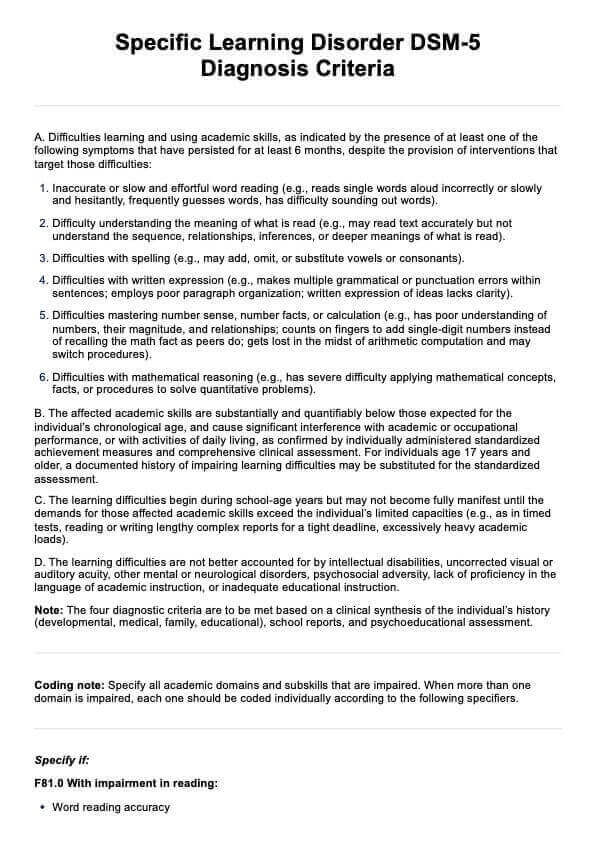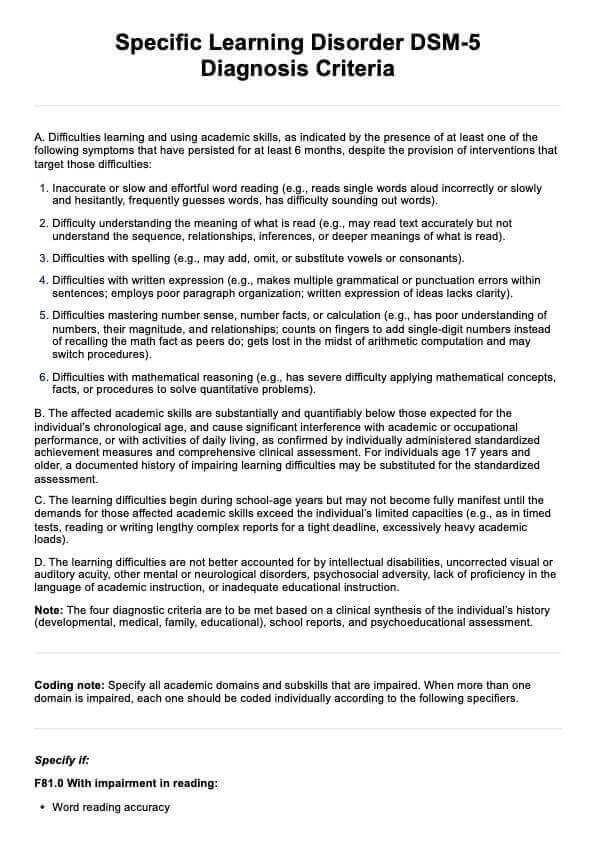Specific Learning Disorder DSM 5 Criteria
Access a comprehensive guide to identifying, diagnosing, and managing learning difficulties with our Specific Learning Disorder DSM-5 Criteria.


What is a specific learning disorder?
A specific learning disorder (SLD) is a neurodevelopmental condition that significantly impacts an individual's ability to acquire knowledge and skills in specific areas, including reading, writing, and mathematics - especially for school-age children. This disorder is often diagnosed during early childhood - however, it may go unrecognized until later stages in life.
According to the Diagnostic and Statistical Manual of Mental Disorders (DSM-5), SLD encompasses three primary types of learning disorders, which fall under the broader category of developmental disabilities. These include:
- Impairment in reading: This refers to difficulties with reading, which can manifest as challenges in decoding words, reading fluency, and comprehension.
- Impairment in written expression: This condition involves difficulties with written expression, affecting a person's ability to write legibly and coherently.
- Impairment in mathematics: This type of learning disorder presents challenges in mathematics, including difficulties with number sense, memorization of arithmetic facts, and performing calculations.
A comprehensive clinical assessment is crucial for accurately diagnosing specific learning disorders, as it allows professionals to differentiate these conditions from other potential learning difficulties.
Specific Learning Disorder DSM 5 Criteria Template
Specific Learning Disorder DSM 5 Criteria Example
How is a specific learning disorder diagnosed?
To diagnose a specific learning disorder, healthcare professionals conduct a comprehensive and multi-faceted assessment that includes several key components:
- Academic skills evaluation: This involves using standardized tests designed to gauge the individual's performance in core areas such as reading, writing, and mathematics. These assessments provide objective data regarding the person's academic abilities compared to age-appropriate norms and help identify specific areas of struggle.
- History and observation: In this step, professionals gather detailed information from various sources, including parents, teachers, and the individual themselves. This collaborative approach helps to build a more holistic understanding of the extent and history of the learning difficulties, including any patterns of behavior that might indicate challenges.
- Exclusion of other conditions: Ensuring the identified learning difficulties are not attributed to other underlying factors is crucial. This involves ruling out conditions such as intellectual disabilities, sensory impairments (like hearing or vision issues), or a lack of educational opportunities that may contribute to academic struggles.
- Duration of symptoms: The individual must demonstrate significant difficulties in academic skills that have persisted for at least six months, even when provided with targeted interventions. This criterion helps to confirm that the challenges are consistent and not just temporary responses to specific situations or changes in the educational environment.
Through this thorough assessment process, healthcare professionals can accurately diagnose specific learning disorders and develop tailored intervention strategies to support the individual’s educational journey.
Specific learning disability DSM-5 diagnostic criteria
The DSM-5 outlines specific criteria for diagnosing SLD:
A. Difficulties learning and using academic skills, as indicated by the presence of at least one of the following symptoms that have persisted for at least 6 months, despite the provision of interventions that target those difficulties:
- Inaccurate or slow and effortful word reading (e.g., reads single words aloud incorrectly or slowly and hesitantly, frequently guesses words, has difficulty sounding out words).
- Difficulty understanding the meaning of what is read (e.g., may read text accurately but not understand the sequence, relationships, inferences, or deeper meanings of what is read).
- Difficulties with spelling (e.g., may add, omit, or substitute vowels or consonants).
- Difficulties with written expression (e.g., makes multiple grammatical or punctuation errors within sentences; employs poor paragraph organization; written expression of ideas lacks clarity).
- Difficulties mastering number sense, number facts, or calculation (e.g., has poor understanding of numbers, their magnitude, and relationships; counts on fingers to add single-digit numbers instead of recalling the math fact as peers do; gets lost in the midst of arithmetic computation and may switch procedures).
- Difficulties with mathematical reasoning (e.g., has severe difficulty applying mathematical concepts, facts, or procedures to solve quantitative problems).
B. The affected academic skills are substantially and quantifiably below those expected for the individual’s chronological age, and cause significant interference with academic or occupational performance, or with activities of daily living, as confirmed by individually administered standardized achievement measures and comprehensive clinical assessment. For individuals age 17 years and older, a documented history of impairing learning difficulties may be substituted for the standardized assessment.
C. The learning difficulties begin during school-age years but may not become fully manifest until the demands for those affected academic skills exceed the individual’s limited capacities (e.g., as in timed tests, reading or writing lengthy complex reports for a tight deadline, excessively heavy academic loads).
D. The learning difficulties are not better accounted for by intellectual disabilities, uncorrected visual or auditory acuity, other mental or neurological disorders, psychosocial adversity, lack of proficiency in the language of academic instruction, or inadequate educational instruction.
Treatment for specific learning disorder
Effective treatments for specific learning disabilities involve a comprehensive approach that combines educational interventions, accommodations, and support services. This holistic strategy addresses individuals' unique challenges with SLD and facilitates their academic and social success.
Educational interventions for learning difficulties
Organized literacy programs that teach phonological awareness and decoding are necessary for dyslexia. Multisensory programs allow pupils to connect with language through auditory, visual, and kinesthetic exercises, improving reading skills. Dysgraphia treatment requires intensive writing instruction. Breaking down writing activities into digestible chunks, focusing on written phrases, and offering guided practice for handwriting and typing aid kids. Multisensory math training helps dyscalculia. Manipulatives, visual aids, and real-world applications may assist kids in understanding arithmetic and solving problems.
Accommodations
Providing additional time for tests and assignments allows students to demonstrate their knowledge without the pressure of time constraints, reducing anxiety and improving performance. Typing on computers can significantly benefit students with writing difficulties, allowing for easier editing and organization of their thoughts. Individualized Education Programs (IEPs) and 504 plans are essential tools that ensure students receive personalized support tailored to their specific needs, including modifications in the classroom setting and assessment methods.
Support services
Psychological counseling can be invaluable in addressing SLD's emotional and social aspects. This support helps students develop coping strategies, build self-esteem, and cultivate resilience as they navigate their educational journeys. Occupational therapy is often recommended for addressing motor coordination difficulties. This therapy can help students enhance their fine motor skills, essential for writing and other classroom tasks.
Successful SLD patients need early assistance to learn how to overcome obstacles. By addressing these challenges early on, we can help pupils succeed academically, socially, and emotionally, making learning more enjoyable.
Commonly asked questions
Learning difficulties affect specific academic skills, whereas intellectual disability impacts overall cognitive functioning and adaptive behaviors. Individuals with SLD typically have average or above-average intelligence but struggle in specific academic areas.
Yes, SLD can co-occur with other neurodevelopmental disorders, such as attention deficit hyperactivity disorder (ADHD) and autism spectrum disorder (ASD), leading to additional challenges in academic and social settings.
Parents and educators play a critical role in identifying early signs of SLD, advocating for appropriate assessments, and ensuring children receive tailored interventions and accommodations to support their academic learning needs.

.jpg)


















-template.jpg)



















































































